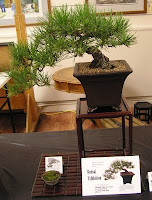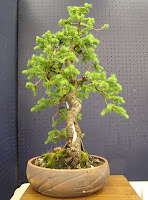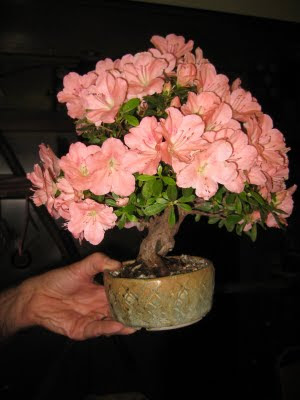Although pines and other winter hardy trees need their dormant period rest, because bonsai are kept in shallow pots there is a danger of your trees dying out. Also some protection of the roots is best to keep the tree healthy.
One way used by many of our club members, and that has worked for my
own pines over many seasons is to heel the tree into the ground, along with a
covering of mulch. Good spots for heeling in your trees include
landscapling areas near the house. Such locations give you the added
benefit of wind protection from the house and in between shrubbery. Plus
you may already have plenty of mulch in these areas. I simply use a
rake or garden hoe to pull away the landscaping mulch, then dig a
shallow trench about as deep as the pots. Place the trees in the
trench, and rake the dirt back in and around the potted trees. Then
pull the mulch back over the pots as well. For most trees, I've
typically heeled them pot and all.
However, it works just as well to slip you bonsai out of the pot, especially if you are unsure whether or not the pot will withstand winter freezing. It is disappointing in the spring to bring the bonsai out of the ground and find that your pot has burst apart from the frost.
Another handy spot that I use are the window wells around the house. In these spots, I put trees that are still in nursery pots. The sunken well is handy and well out of the wind.
I also like to use the tomato garden for some of my larger plants. It is close to the area where I keep a lot of the larger trees that I work with, so I don't have to carry them as far, and it seems to work real well for the bigger pines. During a lot of winters, they stay coated with snow.
I keep some of the less hardy trees like my Japanese maples in an unheated garage that is attached to the house. Because dormant trees will still use a little water, but you must be sure to check these trees occasionally. Watering them is necessary. Be especially vigilant if your trees are in very shallow pots. I lost two prized maples a few winters ago that happened to be in shallow pots, and were watered the same as those in deeper ones. But at some point the moister wasn't adequate and trees had dried out. It was painful to loose two incredible maples. So keep a close eye on them.
--Mike R.
The Akron Canton Bonsai Society was created to understand, enjoy, learn and share ideas about the art of Bonsai. In short: it's all about our trees. We meet on the first Thursday of every month--except December-- at 7:00pm. Meeting locations vary. See also AkronCanton Bonsai on Facebook and Youtube

Sunday, December 11, 2011
Friday, December 9, 2011
David's Wild Tree Project & Winter Tree Protection Ideas

A wild
tree like that can be a lot of fun to work with. Plus the price is right. David
C.sent this photo of something wild that he has been encouraging and trimming
in his back yard. He writes this of the project:
I dug this small tree up from near our property line ,5 or 6 years ago
and moved it so the neighbor wouldn’t mow it down. I keep it cut back for
bonsai stock, it was about 2 feet high, but a deer rutting in our back yard
tore the top off, now its about 1 foot tall and the top 2 branches that he left
are broken, I guess I’ll dig it up and tilt it using the bottom branch as the
new trunk ,I have no idea what it is, the leaves are small and it seems to grow
very slow.
David also added this good view of a spacious cold frame that he has built to winter over some of his trees. Such a cold frame offers good protection from the drying effect of winter winds, while allowing the trees to stay dormant.
 Don't forget that plants will still use a little water while they are dormant, so b be sure to check plant periodically during the winter. Some member let a coating of snow inside the frame to insure that the trees stay moist.
Don't forget that plants will still use a little water while they are dormant, so b be sure to check plant periodically during the winter. Some member let a coating of snow inside the frame to insure that the trees stay moist.
Friday, July 29, 2011
2011 ACBS Show


A well arranged display of several fine bonsai and a steady stream of visitors made for a notable July exhibit from the Akron Canton Bonsai Society. There really is nothing like the annual show to get the creative juices flowing. It really is quite exciting to see each other's trees and how they have progressed this season over last.
Several member trees have now reached a point of refinement that they can be rightly considered specimen trees.
Among the highlights were Dan's (our club president) two amazing junipers which were created from shrubbery that was discarded from a city park several years ago. both are quite large in size and are highlighted with sections of dead wood. These two bonsai get better every year, and it is always exciting to see them. There were also several pine projects, such as Gib's small cascade black pine that was pictured on our show card this time, and some fine scotch pine projects. Mike's 80 year old concord grape has a different look every year, and had three grape clusters for this years show. There were also examples of neatly developed elms, box woods, yews, spruce, and tropicals in the exhibit.
Pictures of the entire exhibit can be seen at our gallery site:
http://picasaweb.google.com/akroncantonbonsai





Monday, July 25, 2011
Leaf Cutting Discussion at July Meeting


Gary talked about reducing the size of leaves on some species of trees. He showed his small sugar maple--a native Ohio tree and an unusual subject for bonsai. The comparison shows the dramatic effect leaf cutting can have. The tree must also be in good health. Also of note-- carlton's
 cool forest and Ken does some leaf cutting of his own.
cool forest and Ken does some leaf cutting of his own.
Monday, July 18, 2011
ACBS's Annual Summer Show

Akron –Canton
Bonsai Society
presents aBonsai
ExhibitionJuly 22nd 23rd & 24th 2011
(concurrent with Fall's Italian Fest)
Cuyahoga Valley Art Center
2131 Front Street
Cuyahoga Falls, Ohio
Admission: free
The exhibition will feature local bonsai artists and contain examples of various bonsai styles and species, including pines, elms, flowering and tropical trees.
Sunday, July 10, 2011
Mike's Pine Discussion Notes from June Meeting

At the June ACBS meeting, we talked a little bit about how to shape our pine projects. The following is a few notes on what we talked about:
- The development of your pine may occur in stages—trunk, branches, foliage pads, refinement and maintenance. Pines are typically a five year project.
- Keep in mind the pine’s growth habit—it has three years worth of needles at this point in the year: the past two which are dark green, and the young light green shoots or candles on the ends of branches. A pine will want to extend outward to get maximum light, and it can grow out of control, if you don’t pinch.
- When pruning your pine remember to keep in mind your purpose. Are you still at the stage where you are trying to develop the trunk, do you want to let a shoot extend some to begin to develop a branch? Are you beginning to create foliage pads?
- Visualize what is happening with the pine’s growth, so you can be selective in which shoots you allow to extend a bit and which you remove.
- Develop and maintain the foliage pads with regular pinching. Keep in mind also that you are keeping the pads compact. Often this means removing the shoots on the ends of branches.
- Remember the Christmas tree growers trick—you can cut into the 2nd year needles if you need to shorten. New shoots will develop back inside these needles.
- Also, here is one other detail that I forgot to mention that will help the partly developed pine. It is a trick that Ken Huth taught me. Sometimes the pine’s branches will get a “French poodle look.” You can improve this look, and at the same time, begin to develop lines and spaces on your tree. Simply pull off the needles on the underside of the branch. I like to use mechanics gloves to do this, as the rubber covered fingers will easily grip and pull off the underside needles—see photos
Creating lines (underside of branches)and spaces (between branches) will also give your pine the look of an old tree

Saturday, June 4, 2011
A New Growing Season: Does it Get More Exciting?

The beginning of a new growing season--can anything be more exciting when it comes to working with bonsai?
Our early June meeting brought out many projects that club members are now experimenting with--and look at the results that Gib shared with his two fine azaleas that are still in bloom. It is terrific that the tree was still in bloom for our meeting, and its blossoms are large and plentiful this year. While he has been under pressure to keep the number of trees to a minimum at home, it is rumored that his wife will permit him to have as many azaleas as he wants. We can all understand that.
It was also good to see how many members are still sharing their progress with last year's black pine extreme workshop. First and foremost, just about everyone's black
 pines were still alive. This will be the season where will will begin to see how the trees respond. It will also give our members a chance to hone their skills. The first bit is learning now how to visualize and work with your pines. Remember to be aware of what you are trying to accomplish with th
pines were still alive. This will be the season where will will begin to see how the trees respond. It will also give our members a chance to hone their skills. The first bit is learning now how to visualize and work with your pines. Remember to be aware of what you are trying to accomplish with the tree as you prune. In some cases you may want to allow new shoots to extend, if your purpose is to create a new branch or apex. In other cases, the there is so little foliage that some needs to be kept to keep the tree healthy or to just thicken the side branches that will take over as new leaders for the tree.
*In other news, while we were unable to secure our viewing area at the art center for a show in June, we are hoping that we can get a weekend spot in early July. This timing will be at the height of the growing season and should allow for some interesting trees for display.
*One other observation: It has been exciting to see how many of our newer members are beginning to pick up their skill level--not just in their ability to prune and wire, but in their selection of nursery stock and collected material that they are using to start new projects. Members are encouraged to keep a photo log of their projects. In time, the early photos will be invaluable testimony to the how both the tree and the bonsai artist progress and grow.

Saturday, May 7, 2011
May ACBS Meeting Brings Excitement Over Projects
 The May meeting of the Akron-Canton Bonsai Society brought a lot of excitement over the new growing season, and over all of the various club projects that members will be continuing through the summer.
The May meeting of the Akron-Canton Bonsai Society brought a lot of excitement over the new growing season, and over all of the various club projects that members will be continuing through the summer.There were a couple of crab apples at the meeting that were grown from stumps last summer that were currently in bloom. Despite their only partial development, they offered a good variety of color to the meeting and brought lost of speculation about how they'll look in future seasons.
 Also, maples, azaleas, boxwood, juniper and black pine were shared at the meeting. Cheryl B brought in a Korean lilac that had multiple buds ready to break open. Hopefully she'll send us a
Also, maples, azaleas, boxwood, juniper and black pine were shared at the meeting. Cheryl B brought in a Korean lilac that had multiple buds ready to break open. Hopefully she'll send us a picture that we can post.
Given the tough winter we had this year, and record setting rains--as well as a May 6 frost--it was refreshing to see the bonsai begin to break out. There is just something happy in the bright green of fresh new foliage.



Saturday, April 16, 2011
April Meeting Brings Out the Trees




With the long and tough winter we had in northeast Ohio, most of us have trouble remembering what green looks like. But the April meeting of the Akron-Canton Bonsai Society finally brought out the trees. Members were sharing some of their spring projects that were trying real hard to bud out. To mention just a few. Anne begins working with a trident maple, and Carlton shared a couple of projects-- his forest planting and a dawn redwood.
There is something about the bright shade of green in freshly opened leaf buds that just makes a person happy to look at them. That vibrant green also cues you to think about a new growing season, and visualize what your bonsai trees might become. More project updates to follow. I'm especially looking forward to seeing how our members' pine plantings and extreme bending attempts from last season develop.
Friday, January 7, 2011
Planning at the January Meeting


The typical northeast Ohio weather made travel difficult, and so we lacked our usual membership at the January meeting. Nevertheless, Gib still plugged away on this awesome little white pine, and some good ideas for workshops, demos, perhaps a project tree species for the year, and other club activities were tossed around.
Don't forget you 2011 dues--still on 20 bucks, and also please turn in the member profile sheet to Dan.
Saturday, January 1, 2011
Bring a Tree & Help Us Plan at the January Meeting

Happy New Year from the Akron Canton Bonsai Society!
The next ACBS meeting will be Thursday, January 6th at 7:00 at the Cuyahoga Valley Arts Center in Cuyahoga Falls, Ohio. The meeting focus will be two fold:
- Bring a tree to work on
- Planning for the coming year
It's always fun to collaborate on projects, so bring a tree to work on at this meeting. It is always good to see what projects other members have on their plate, and how these trees develop over time.
Also, think about what programs that might be of interest and what artistic or horticultural skills you might like to acquire or develop. See you there.
Subscribe to:
Comments (Atom)


